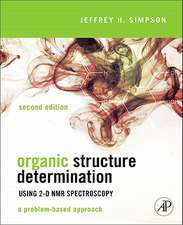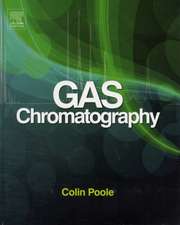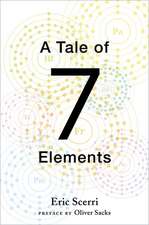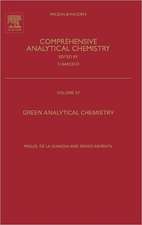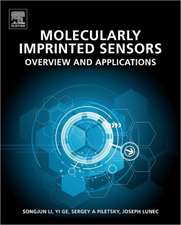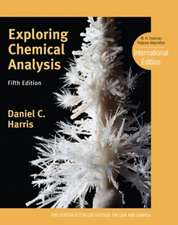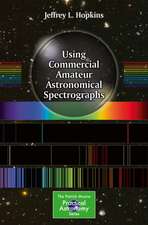High Resolution NMR Spectroscopy in Solids: NMR Basic Principles and Progress, cartea 11
Autor M. Mehringen Limba Engleză Paperback – 21 ian 2012
Din seria NMR Basic Principles and Progress
-
 Preț: 384.48 lei
Preț: 384.48 lei - 15%
 Preț: 633.19 lei
Preț: 633.19 lei - 18%
 Preț: 951.47 lei
Preț: 951.47 lei - 15%
 Preț: 635.47 lei
Preț: 635.47 lei - 18%
 Preț: 1119.71 lei
Preț: 1119.71 lei - 18%
 Preț: 942.76 lei
Preț: 942.76 lei - 15%
 Preț: 635.47 lei
Preț: 635.47 lei - 18%
 Preț: 950.96 lei
Preț: 950.96 lei - 15%
 Preț: 647.92 lei
Preț: 647.92 lei - 5%
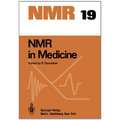 Preț: 711.32 lei
Preț: 711.32 lei - 15%
 Preț: 574.95 lei
Preț: 574.95 lei - 15%
 Preț: 638.89 lei
Preț: 638.89 lei - 15%
 Preț: 636.63 lei
Preț: 636.63 lei - 15%
 Preț: 639.41 lei
Preț: 639.41 lei - 15%
 Preț: 639.59 lei
Preț: 639.59 lei - 15%
 Preț: 635.01 lei
Preț: 635.01 lei - 18%
 Preț: 944.67 lei
Preț: 944.67 lei - 18%
 Preț: 945.30 lei
Preț: 945.30 lei - 18%
 Preț: 940.39 lei
Preț: 940.39 lei - 15%
 Preț: 635.15 lei
Preț: 635.15 lei - 15%
 Preț: 634.68 lei
Preț: 634.68 lei - 15%
 Preț: 640.37 lei
Preț: 640.37 lei - 15%
 Preț: 637.13 lei
Preț: 637.13 lei - 18%
 Preț: 941.38 lei
Preț: 941.38 lei - 18%
 Preț: 940.72 lei
Preț: 940.72 lei - 18%
 Preț: 936.95 lei
Preț: 936.95 lei - 18%
 Preț: 937.09 lei
Preț: 937.09 lei - 15%
 Preț: 643.99 lei
Preț: 643.99 lei - 15%
 Preț: 635.96 lei
Preț: 635.96 lei - 15%
 Preț: 632.05 lei
Preț: 632.05 lei - 15%
 Preț: 633.53 lei
Preț: 633.53 lei - 15%
 Preț: 631.07 lei
Preț: 631.07 lei
Preț: 640.71 lei
Preț vechi: 753.77 lei
-15% Nou
Puncte Express: 961
Preț estimativ în valută:
122.60€ • 128.35$ • 101.44£
122.60€ • 128.35$ • 101.44£
Carte tipărită la comandă
Livrare economică 05-19 aprilie
Preluare comenzi: 021 569.72.76
Specificații
ISBN-13: 9783642963346
ISBN-10: 364296334X
Pagini: 264
Ilustrații: XII, 248 p.
Dimensiuni: 170 x 244 x 14 mm
Greutate: 0.43 kg
Ediția:Softcover reprint of the original 1st ed. 1976
Editura: Springer Berlin, Heidelberg
Colecția Springer
Seria NMR Basic Principles and Progress
Locul publicării:Berlin, Heidelberg, Germany
ISBN-10: 364296334X
Pagini: 264
Ilustrații: XII, 248 p.
Dimensiuni: 170 x 244 x 14 mm
Greutate: 0.43 kg
Ediția:Softcover reprint of the original 1st ed. 1976
Editura: Springer Berlin, Heidelberg
Colecția Springer
Seria NMR Basic Principles and Progress
Locul publicării:Berlin, Heidelberg, Germany
Public țintă
ResearchCuprins
1. Introduction.- 2. Nuclear Spin Interactions in Solids.- 2.1 Basic Nuclear Spin Interactions in Solids.- 2.2 Spin Interactions in High Magnetic Fields.- 2.3 Transformation Properties of Spin Interactions in Real Space.- 2.4 Powder Spectrum Line Shapes.- 2.5 Specimen Rotation.- 2.6 Rapid Anisotropic Molecular Rotation.- 2.7 Line Shapes in the Presence of Molecular Reorientation.- 3. Multiple-Pulse NMR Experiments.- 3.1 Idealized Multiple-Pulse Sequences.- 3.2 The Four-Pulse Sequence (WHH4).- 3.3 Coherent Averaging Theory.- 3.4 Application of Coherent Averaging Theory to Multiple-Pulse Sequences.- 3.5 Arbitrary Rotations in Multiple-Pulse Experiments.- 3.6 Second Averaging.- 3.7 The Influence of Pulse Imperfection on Multiple-Pulse Experiments.- 3.8 Resolution of Multiple-Pulse Experiments.- 3.9 Magic Angle Rotating Frame Line Narrowing Experiments.- 4. Double Resonance Experiments.- 4.1 Basic Principles of Double Resonance Experiments.- 4.2 Cross-Polarization of Dilute Spins.- 4.3 Cross-Polarization Dynamics.- 4.4 Spin Decoupling Dynamics.- 5. Magnetic Shielding Tensor.- 5.1 Ramsey’s Formula.- 5.2 Approximate Calculations of the Shielding Tensor.- 5.3 Proton Shielding Tensors.- 5.4 19F Shielding Tensors.- 5.5 13C Shielding Tensors.- 5.6 Other Shielding Tensors.- 6. Spin-Lattice Relaxation in Line Narrowing Experiments.- 6.1 Spin-Lattice Relaxation in Multiple-Pulse Experiments.- 6.2 Application of Multiple-Pulse Experiments to the Investigation of Spin-Lattice Relaxation.- 6.3 Spin-Lattice Relaxation in Dilute Spin Systems.- 7. Appendix.- A. Irreducible Tensor Representation of Spin Interactions.- B. Rotations.- C. Contribution of Non-Secular Shielding Tensor Elements to the Resonance Shift.- D. Bloch Siegert Shift.- E. General Line Shape Theory.- References.

